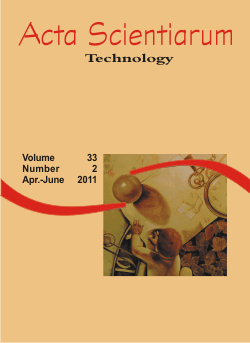<b>Use of agroindustrial residues in biotechnological process by beta-galactosidase production from <em>Kluyveromyces marxianus</em> CCT 7082</b> - doi: 10.4025/actascitechnol.v33i2.9919
DOI:
https://doi.org/10.4025/actascitechnol.v33i2.9919Keywords:
experimental design, cheese whey, corn steep liquor, Prodex-lacAbstract
The objective of this work was to evaluate the composition of the culture medium for the production of the enzyme β-galactosidase from Kluyveromyces marxianus CCT 7082 using an experimental design. Enzyme production was carried out in a medium consisting of cheese whey, corn steep liquor (CSL) and Prodex-lac® yeast hydrolyzate. A factorial fractional design (25-1) was performed to determine the significant variables in the production of the enzyme. Different concentrations of lactose present in whey (10-70 g L-1), CSL (10-100 g L-1), Prodex-lac (40-20 g L-1), (NH4)2SO4 (0-10 g L-1) and pH (5-7) were tested. Lactose concentration, CSL and pH were the variables that showed a statistically significant effect on enzyme activity within the ranges studied, and these variables were used in a central composite rotatable design to optimize production of the enzyme. The ranges used were: lactose concentration 40-100 g L-1, CSL 10-120 g L-1, and pH 3.5-6.5. The conditions that resulted in higher enzyme activity (1400 U g -1) were 70 g L-1 lactose, 65 g L-1 CSL, 4 g L-1 Prodex-lac and pH 5, yielding 61 U L-1 h-1.Downloads
Download data is not yet available.
Downloads
Published
2011-02-23
How to Cite
Manera, A. P., Ores, J. da C., Ribeiro, V. A., Rodrigues, M. I., Kalil, S. J., & Maugeri Filho, F. (2011). <b>Use of agroindustrial residues in biotechnological process by beta-galactosidase production from <em>Kluyveromyces marxianus</em> CCT 7082</b> - doi: 10.4025/actascitechnol.v33i2.9919. Acta Scientiarum. Technology, 33(2), 155–161. https://doi.org/10.4025/actascitechnol.v33i2.9919
Issue
Section
Biotechnology
License
DECLARATION OF ORIGINALITY AND COPYRIGHTS
I Declare that current article is original and has not been submitted for publication, in part or in whole, to any other national or international journal.
The copyrights belong exclusively to the authors. Published content is licensed under Creative Commons Attribution 4.0 (CC BY 4.0) guidelines, which allows sharing (copy and distribution of the material in any medium or format) and adaptation (remix, transform, and build upon the material) for any purpose, even commercially, under the terms of attribution.
Read this link for further information on how to use CC BY 4.0 properly.











8.png)




